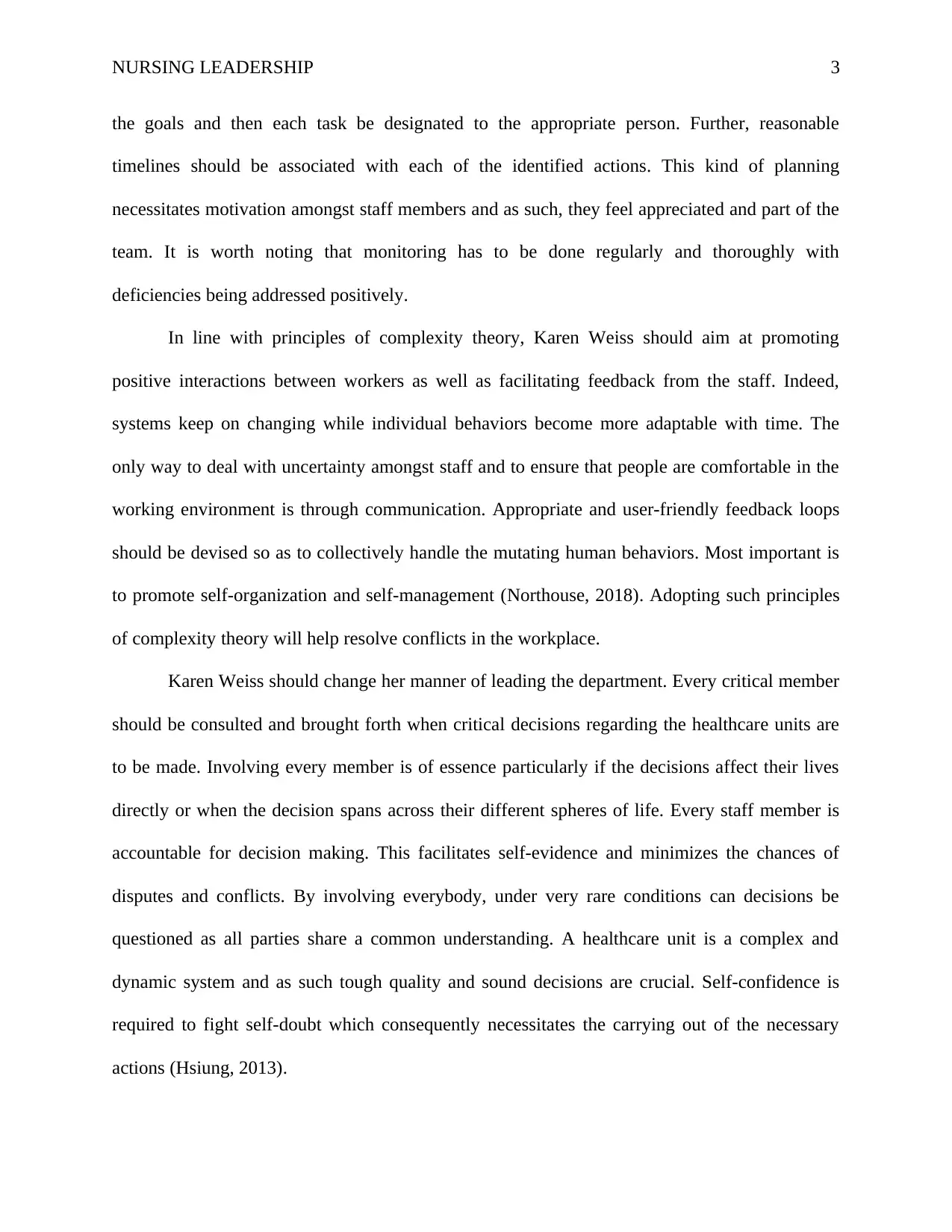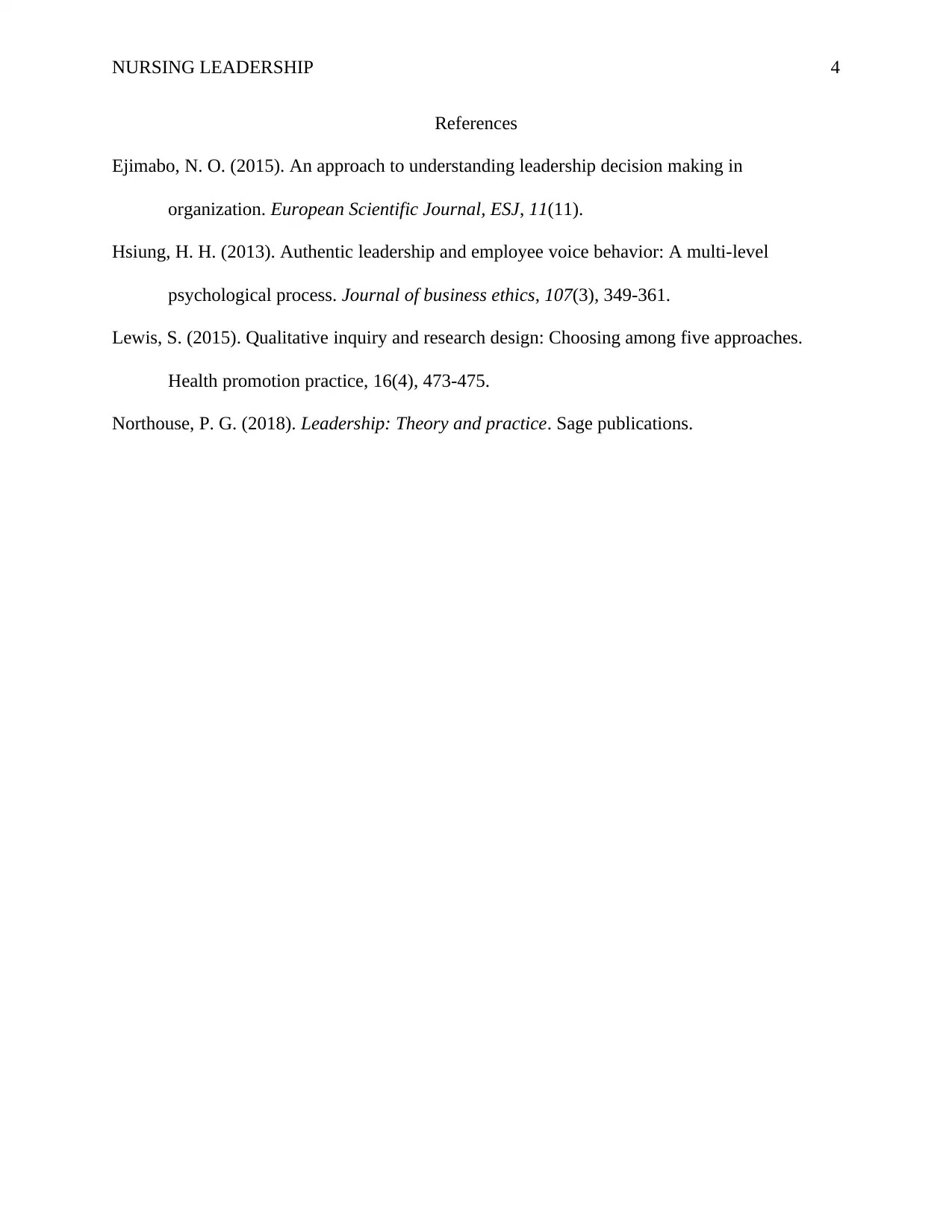Nursing Leadership: Effective Strategies in Population-Based Approach
VerifiedAdded on 2023/06/10
|4
|813
|127
Essay
AI Summary
This essay examines the shift from traditional leadership models to population-based approaches in healthcare, focusing on Karen Weiss's challenges in leading her team through these changes. It highlights the importance of data-driven decision-making, resource planning, and setting achievable goals. The essay emphasizes the need for Karen to adopt principles of complexity theory, promote positive interactions, and facilitate open communication to resolve conflicts and foster a comfortable working environment. It suggests involving all team members in decision-making to enhance accountability and minimize disputes, ultimately improving the quality and soundness of decisions within the dynamic healthcare system.

Running head: NURSING LEADERSHIP 1
Nursing Leadership
Student’s Name
Institutional Affiliation
Nursing Leadership
Nursing Leadership
Student’s Name
Institutional Affiliation
Nursing Leadership
Paraphrase This Document
Need a fresh take? Get an instant paraphrase of this document with our AI Paraphraser

NURSING LEADERSHIP 2
Traditional models of leadership are becoming extinct with modern and improved
strategies replacing them. In the healthcare system, the population-based approach is gaining
popularity with most health units adopting it. The models aim at promoting the overall health
status of the patients regardless of their background or economic status. It is a disease prevention
strategy. As such population-based approach advocates for leadership that targets on planning
and addressing the needs of the patients. It is committed to eliminating the gaps in terms of
quality of service delivery in the healthcare units. Planning requires that managers and the heads
of department gather the necessary data and information from several levels in the care units to
help make appropriate decisions. Without this skill, leaders are bound to be in conflict with the
system and the staff at large (Lewis, 2015).
The changes that come about from implementation of population-based approach puts
Karen Weiss in a tight position when it comes to leading other staff members. The needs of the
patients, as well as those of the staff, require to always be matched with relevant services. Gaps
will always exist, but the fact that the needs were unmet does not mean everything has failed but
signifies a deficiency. Unmet needs should always be identified. With prioritization, issues
within a healthcare unit can effectively be resolved with time. The biggest issue, in this case, is
that Karen Weiss has a problem addressing these needs as well as using SWOT analysis to help
identify opportunities and solutions to the problems facing her department. To effectively
improve her leadership, she needs to identify all the critical resources that will help make the
desired changes. She also needs to plan for these resources carefully to avoid scope creep
(Ejimabo, 2015).
To better manage and lead the team, she needs to set achievable short-term, medium and
long-time goals to her staff. Required actions and responsibilities ought to be attached to each of
Traditional models of leadership are becoming extinct with modern and improved
strategies replacing them. In the healthcare system, the population-based approach is gaining
popularity with most health units adopting it. The models aim at promoting the overall health
status of the patients regardless of their background or economic status. It is a disease prevention
strategy. As such population-based approach advocates for leadership that targets on planning
and addressing the needs of the patients. It is committed to eliminating the gaps in terms of
quality of service delivery in the healthcare units. Planning requires that managers and the heads
of department gather the necessary data and information from several levels in the care units to
help make appropriate decisions. Without this skill, leaders are bound to be in conflict with the
system and the staff at large (Lewis, 2015).
The changes that come about from implementation of population-based approach puts
Karen Weiss in a tight position when it comes to leading other staff members. The needs of the
patients, as well as those of the staff, require to always be matched with relevant services. Gaps
will always exist, but the fact that the needs were unmet does not mean everything has failed but
signifies a deficiency. Unmet needs should always be identified. With prioritization, issues
within a healthcare unit can effectively be resolved with time. The biggest issue, in this case, is
that Karen Weiss has a problem addressing these needs as well as using SWOT analysis to help
identify opportunities and solutions to the problems facing her department. To effectively
improve her leadership, she needs to identify all the critical resources that will help make the
desired changes. She also needs to plan for these resources carefully to avoid scope creep
(Ejimabo, 2015).
To better manage and lead the team, she needs to set achievable short-term, medium and
long-time goals to her staff. Required actions and responsibilities ought to be attached to each of

NURSING LEADERSHIP 3
the goals and then each task be designated to the appropriate person. Further, reasonable
timelines should be associated with each of the identified actions. This kind of planning
necessitates motivation amongst staff members and as such, they feel appreciated and part of the
team. It is worth noting that monitoring has to be done regularly and thoroughly with
deficiencies being addressed positively.
In line with principles of complexity theory, Karen Weiss should aim at promoting
positive interactions between workers as well as facilitating feedback from the staff. Indeed,
systems keep on changing while individual behaviors become more adaptable with time. The
only way to deal with uncertainty amongst staff and to ensure that people are comfortable in the
working environment is through communication. Appropriate and user-friendly feedback loops
should be devised so as to collectively handle the mutating human behaviors. Most important is
to promote self-organization and self-management (Northouse, 2018). Adopting such principles
of complexity theory will help resolve conflicts in the workplace.
Karen Weiss should change her manner of leading the department. Every critical member
should be consulted and brought forth when critical decisions regarding the healthcare units are
to be made. Involving every member is of essence particularly if the decisions affect their lives
directly or when the decision spans across their different spheres of life. Every staff member is
accountable for decision making. This facilitates self-evidence and minimizes the chances of
disputes and conflicts. By involving everybody, under very rare conditions can decisions be
questioned as all parties share a common understanding. A healthcare unit is a complex and
dynamic system and as such tough quality and sound decisions are crucial. Self-confidence is
required to fight self-doubt which consequently necessitates the carrying out of the necessary
actions (Hsiung, 2013).
the goals and then each task be designated to the appropriate person. Further, reasonable
timelines should be associated with each of the identified actions. This kind of planning
necessitates motivation amongst staff members and as such, they feel appreciated and part of the
team. It is worth noting that monitoring has to be done regularly and thoroughly with
deficiencies being addressed positively.
In line with principles of complexity theory, Karen Weiss should aim at promoting
positive interactions between workers as well as facilitating feedback from the staff. Indeed,
systems keep on changing while individual behaviors become more adaptable with time. The
only way to deal with uncertainty amongst staff and to ensure that people are comfortable in the
working environment is through communication. Appropriate and user-friendly feedback loops
should be devised so as to collectively handle the mutating human behaviors. Most important is
to promote self-organization and self-management (Northouse, 2018). Adopting such principles
of complexity theory will help resolve conflicts in the workplace.
Karen Weiss should change her manner of leading the department. Every critical member
should be consulted and brought forth when critical decisions regarding the healthcare units are
to be made. Involving every member is of essence particularly if the decisions affect their lives
directly or when the decision spans across their different spheres of life. Every staff member is
accountable for decision making. This facilitates self-evidence and minimizes the chances of
disputes and conflicts. By involving everybody, under very rare conditions can decisions be
questioned as all parties share a common understanding. A healthcare unit is a complex and
dynamic system and as such tough quality and sound decisions are crucial. Self-confidence is
required to fight self-doubt which consequently necessitates the carrying out of the necessary
actions (Hsiung, 2013).
⊘ This is a preview!⊘
Do you want full access?
Subscribe today to unlock all pages.

Trusted by 1+ million students worldwide

NURSING LEADERSHIP 4
References
Ejimabo, N. O. (2015). An approach to understanding leadership decision making in
organization. European Scientific Journal, ESJ, 11(11).
Hsiung, H. H. (2013). Authentic leadership and employee voice behavior: A multi-level
psychological process. Journal of business ethics, 107(3), 349-361.
Lewis, S. (2015). Qualitative inquiry and research design: Choosing among five approaches.
Health promotion practice, 16(4), 473-475.
Northouse, P. G. (2018). Leadership: Theory and practice. Sage publications.
References
Ejimabo, N. O. (2015). An approach to understanding leadership decision making in
organization. European Scientific Journal, ESJ, 11(11).
Hsiung, H. H. (2013). Authentic leadership and employee voice behavior: A multi-level
psychological process. Journal of business ethics, 107(3), 349-361.
Lewis, S. (2015). Qualitative inquiry and research design: Choosing among five approaches.
Health promotion practice, 16(4), 473-475.
Northouse, P. G. (2018). Leadership: Theory and practice. Sage publications.
1 out of 4
Related Documents
Your All-in-One AI-Powered Toolkit for Academic Success.
+13062052269
info@desklib.com
Available 24*7 on WhatsApp / Email
![[object Object]](/_next/static/media/star-bottom.7253800d.svg)
Unlock your academic potential
Copyright © 2020–2025 A2Z Services. All Rights Reserved. Developed and managed by ZUCOL.





